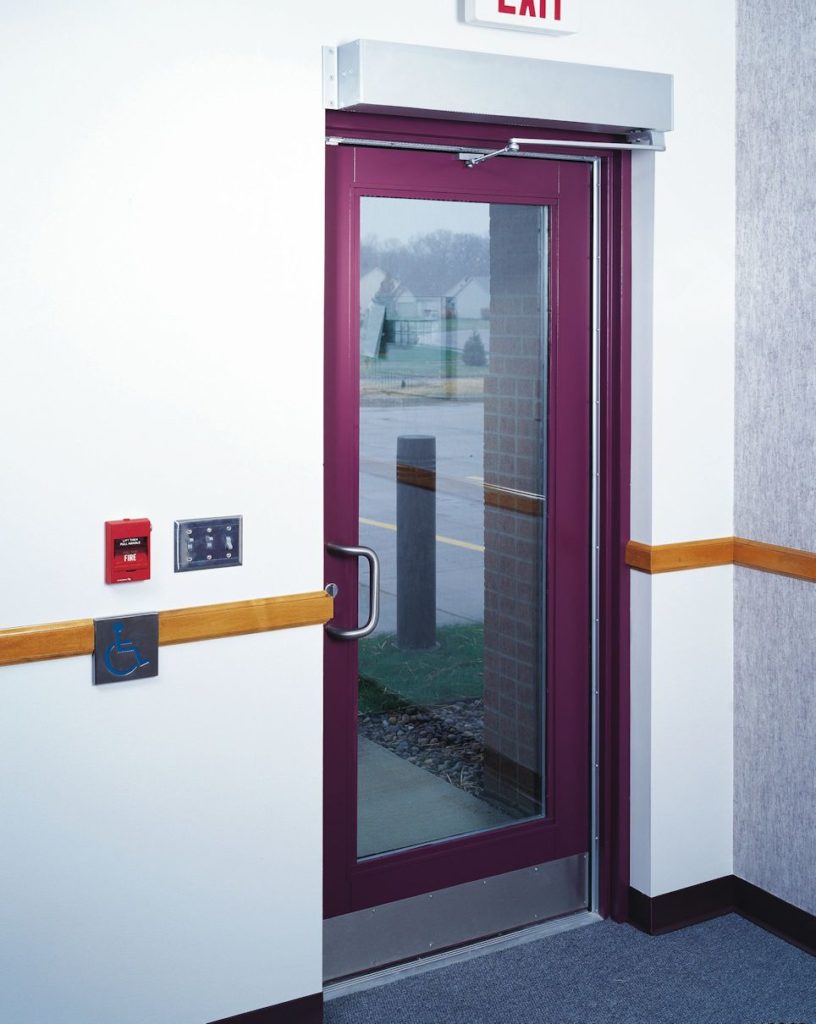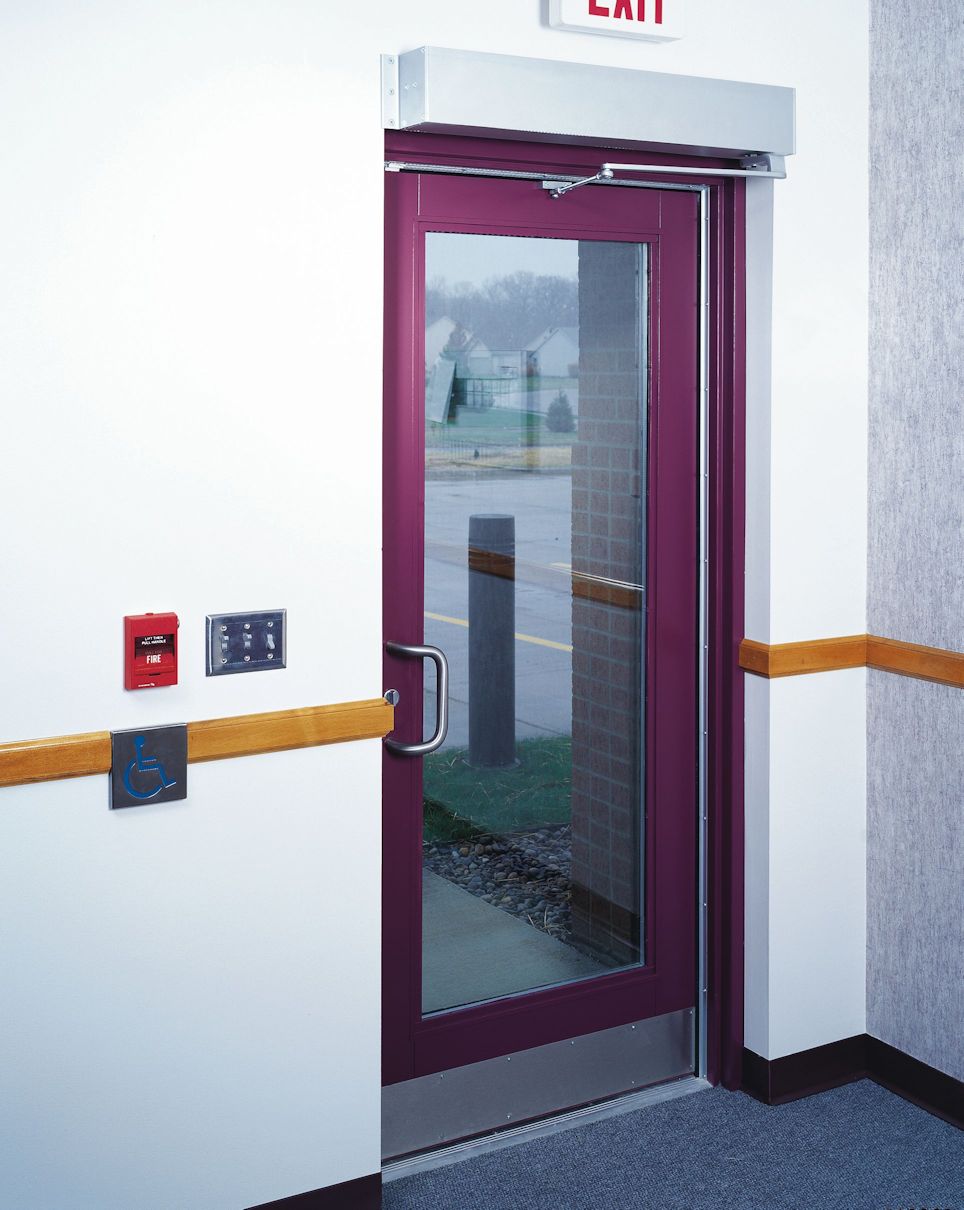 When the 2010 ADA Standards for Accessible Design were released, they introduced a requirement for doors with automatic operators to have the required maneuvering clearance for manual doors on the egress side of the door. An exception to this requirement is when standby power is provided (or when the door stays open when power is cut).
When the 2010 ADA Standards for Accessible Design were released, they introduced a requirement for doors with automatic operators to have the required maneuvering clearance for manual doors on the egress side of the door. An exception to this requirement is when standby power is provided (or when the door stays open when power is cut).
To rephrase, if an automatic door has the required amount of maneuvering clearance on the egress side, standby power for the operator is not mandated by the standards. But if the door does not have the required amount of maneuvering clearance on the egress side, adding standby power would be a way to overcome the problem by allowing the door to function as an accessible means of egress – even during a power failure. There’s a good example on this blog post.
Here’s where this is found in the 2010 ADA standards:
404.3.2 Maneuvering Clearance. Clearances at power-assisted doors and gates shall comply with 404.2.4. Clearances at automatic doors and gates without standby power and serving an accessible means of egress shall comply with 404.2.4.
EXCEPTION: Where automatic doors and gates remain open in the power-off condition, compliance with 404.2.4 shall not be required.
A similar section was added to the 2017 edition of ICC A117.1 – Accessible and Usable Buildings and Facilities:
404.3.4 Maneuvering clearances. Maneuvering clearances at power-assisted doors and gates shall comply with Section 404.2.3. Maneuvering clearances complying with Section 404.2.3 shall be provided on the egress side of low-energy automatic and full power automatic doors and gates that serve as part of an accessible means of egress.
Exceptions:
1. Low-energy automatic and full power automatic doors and gates that have standby power or battery back-up shall not be required to comply with this section.
Remember, the standby power is only required if the door does not have the proper maneuvering clearance on the egress side (and if the door doesn’t stay open when power is cut).
Here are my questions for you:
- How do you provide the required standby power if there isn’t building-wide backup power?
- Which standby power units work well with automatic operators?
- Are there any pitfalls to watch out for?
- How do you handle fire doors, where the automatic operator must be deactivated upon fire alarm?
.
WWYD?
You need to login or register to bookmark/favorite this content.






How do you provide the required standby power if there isn’t building-wide backup power?
Some of the products have a battery backup option that you can select, or I have used an UPS from a company such as APC. You just need to do a little ohms law to figure out required watts needs based on AMPs the unit draws.
Which standby power units work well with automatic operators?
Again I have used either APC, or Tripp-lite
Are there any pitfalls to watch out for?
Disabling the hold open button, number of cycles or time unit is required to work.
How do you handle fire doors, where the automatic operator must be deactivated upon fire alarm?
I would think that the opening and the design would need to be reworked, I am not willing to just toss in the towel and say to bad so sad fire over ADA. I still think that if the unit continues to operate normally and everything works as required during loss of power why would you need to cut power to it other than that silly code thing.
Maybe power operators should have a Fire rated option like exit devices, Fire rated device dogging is not an option, maybe a fire rated ADO has a FA interface, no hold-open switch and is setup for BB.
Thanks Brendan!
– Lori
How do you provide the required standby power if there isn’t building-wide backup power?
– UPS (uninterrupted power supply) units are manufactured for by most automatic door companies and fit easily inside of headers. They can also be run off external SLA Batteries.
Which standby power units work well with automatic operators?
-See manufacturer for options
Are there any pitfalls to watch out for?
-Space. Depending on what is being controlled out of the automatic door header (strikes, panics, etc.) there may be multiple relays and other components mounted inside of the header. May need to have allowance for external SLA Batteries + conduit from external source to header.
How do you handle fire doors, where the automatic operator must be deactivated upon fire alarm?
-You can tie a fire alarm contact into the auto door header to drop hold open on closer. This would be a normally closed dry contact off of a fire alarm relay supplied by electrical.
Thanks Mat!
– Lori
How do you handle fire doors, where the automatic operator must be deactivated upon fire alarm.
-NFPA 80 section 6.1.3.4 states that an automatic fire door must disengage at the time of a fire alarm and close and latch
it basically becomes a manual door where you can exit using panic hardware but not re-enter.
Most automatic door controllers have a set of terminals for the fire alarm to tie into. At the time of the alarm, the contacts either open
or close (usually open) and the automatic door will immediately close and latch. Standby power is not a requirement.
Thanks Len –
I was wondering if anyone has found a solution for doors that require standby power because of the maneuvering clearance, but are also fire doors that have to be deactivated upon fire alarm.
– Lori
The Norton 5800 Series ADAEZ Low Energy Operator has a built in battery pack that would power the operator 2000 times in a row upon loss of power to the building or system. The operator mounts on the door similar to a door closer and is run off a 24VDC (500mA) power source. The 5800 complies with ANSI A156.19 and is UL10c rated for 90 minute fire doors. Don’t let the small size fool you – the Norton 5800 is rated for 250lb, 48″ wide doors in high wind or abusive environments. A wireless interface module for WIM allows the operator to connect to the fire panel and a host of other peripheral devices.
See YouTube video here: https://youtu.be/Nwz0XnjwjMc
Jay Vaitkus
Director of Business Development – Norton/Rixson
ASSA ABLOY Access and Egress Hardware Group